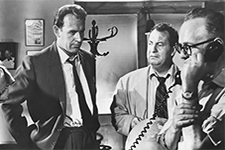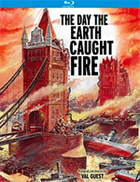The Day the Earth Caught Fire
|  Despite its sensationalist, marquee-ready title, Val Guest’s The Day the Earth Caught Fire is one of the more thoughtful and sobering atomic-scare films of the Cold War era. While most science fiction movies of the 1950s and ’60s imagined nuclear nightmare via rampaging monsters and horrible mutated nature, Guest’s film, which he cowrote with novelist, playwright, and screenwriter Wolf Mankowitz (A Kid for Two Farthings), is uncommonly intelligent in its treatment of a truly horrific doomsday scenario: the United States and the Soviet Union, having simultaneously set off atomic test blasts at the North and South Poles, knock the planet 11 degrees off its axis, sending it on a slow collision course with the sun. This leads to all manner of increasingly horrible atmospheric anomalies, beginning with a mysterious “heat mist” that envelopes major cities and ending with surface temperatures that cause rivers to dry up and set many cities on fire (hence the title). Guest and Mankowitz wisely structure the film as a mystery and align the audience with Peter Stenning (Edward Judd), a one-time star reporter for London’s Daily Express whose alcoholism has cost him both his marriage and his status. Peter, despite being a fallen star, still has a nose for a good story, and his persistence in talking with various stonewalling government officers and scientists about what he thinks is just a lame assignment about sunspots eventually pays off. His best source of information turns out to be Jeannie Craig (Janet Munro), a typist at the British Meteorological Office with whom he becomes romantically involved. The film presents the various British government agents not as nefarious villains trying to hide misdeeds, but rather as workaday bureaucrats who are grappling with an incredible situation far outside their control. One of the film’s real strengths is its resistance to easy villainizing; rather, its doomsday scenario is presented as an accumulation of events for which no one actor is responsible. The Day the Earth Caught Fire is arguably as much a fast-paced newsroom drama as it is an apocalyptic sci-fi movie, one that ranks with The Front Page (1930), His Girl Friday (1940), All the President’s Men (1976), and The Post (2017) in its depiction of the complex world of high-stakes journalism. The majority of the action takes place within the walls of the harried Daily Express newsroom, with its clacking typewriters, whirring teletype machines, ringing phones, and endless cigarettes, and the film displays a genuine sense of admiration and affection for the hard-nosed resilience of journalists and the difficult balance they must strike between their desire to get to the truth and the reality of putting out a paper on deadline each day. Guest, who was himself a former journalist (he worked as the London correspondent for The Hollywood Reporter), builds into the newsroom scenes a determined sense of realism, which is heightened by the presence of Arthur Christiansen, the actual editor of the Daily Express from 1933 to 1957, playing the paper’s no-nonsense, practically minded editor. Granted, the rat-a-tat-tat dialogue that is always right on point is pure movie fantasy, but it is the language with which we understand journalism on the screen, and it works. Guest was a prolific writer, producer, and director, and at the time he made The Day the Earth Caught Fire, he was in the midst of a particularly fertile period in which he was exercising more independence and taking some risks after having established himself as a genre director-par-excellence with Hammer films like The Quartermass Xperiment (1955), its sequel Quartermass II (1957), and The Abominable Snowman (1957). He had actually begun his career directing comedies, which helps account for why the timing and the dialogue are so sharp in The Day the Earth Caught Fire. You can really sense this in the back-and-forth between Peter and Jeannie, the latter of whom is a strong, independent single woman with a clear sexual identity and the ability to manage Peter’s direct advances. Munro had recently starred in three Disney live-action films—Darby O’Gill and the Little People (1959), Third Man on the Mountain (1959), and Swiss Family Robinson (1960)—and she was clearly eager to stake her claim to more adult roles. She and Edward Judd, who at the time was known primarily for his work on television, have good chemistry, which helps sell the speed at which their relationship develops. As a doomsday movie with a title like The Day the Earth Caught Fire, there are certainly expectations regarding the film’s visuals, and while they are certainly hampered by a limited budget, the special effects get the job done when needed. Guest has to rely heavily on stock footage (some of which clearly comes from the London Blitz, which is referenced frequently throughout the film), but the effects team puts together some impressive visions of London in a state of near destruction, with the River Thames dried up and the sun-baked streets virtually empty. To enhance the sense of desolation, the opening and closing sequences, which take place when the planet is at the point of no return, are presented in a yellowish sepia, rather than the clear black-and-white of the rest of the film. The cinematographer, Harry Waxman, a 20-year veteran who would go on to shoot Cornel Wilde’s Sword of Lancelot (1963) and Robin Hardy’s The Wicker Man (1973), uses the wide CinemaScope frame cleverly and efficiently, submerging us in the intense business of the bustling newsroom while also giving us expansive vistas of growing destruction. Like many science fiction films of its era, The Day the Earth Caught Fire displays a deep wariness of nuclear power and a recognition that its use could spell the end of humanity, although the ultimate irony is that, as in Godzilla (1954), atomic weapons are both the source of and possibly the only solution to utter catastrophe. The lingering image near the end of the film of two front pages, one conceding the doom of the human race and the other celebrating its salvation, is rightly famous for its ambiguity and its recognition of how the greatest of scientific discoveries hold the power to both save and destroy.
Copyright © 2020 James Kendrick Thoughts? E-mail James Kendrick All images copyright © Kino Lorber | |||||||||||||||||||||||||||||||
Overall Rating: 


 (3.5)
(3.5)


